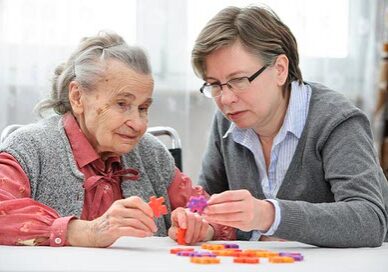Home | Altura Blog |
Dignity of Risk
November 26, 2021 | Altura Blog
Topic:
Rights & Responsibilities
‘Dignity of Risk’ is an unusual term to describe something that many of us take for granted every day, yet for others it could mean the difference between being able to make a simple cup of tea… or not. It’s a concept that was first expressed in 1972, in an article by the author and theologian, Robert Perske, who wrote, “…Overprotection may appear on the surface to be kind, but it can be really evil. An oversupply can smother people emotionally, squeeze the life out of their hopes and expectations, and strip them of their dignity. Overprotection can keep people from becoming all they could become.”[1]
Whilst Perske was advocating for the rights of people living with a mental health condition, the term “dignity of risk” has become universally recognised as a means of understanding the importance of self-determination for any individual, especially those who might be considered vulnerable in any way, such as people living with a disability, children or older people.
What is Dignity of Risk in residential care?
In Altura Learning’s course, “Dignity of Risk”, we look at the benefits of applying the concept to the care home environment, including benefits for the organisation, staff and most importantly, the residents. We also examine the barriers that prevent some organisations from fully embracing the idea. Lawyer Dr Melanie Tan defines the concept as being about the “right to self determination, the right of the person to make their own decisions, free from any interference”. Marta Woolford, a PhD candidate specialising in Dignity of Risk in residential care, says it is about “enabling an individual to live a life that, as much as possible, accords with their own values and their own choices. It will mean something different to everyone.” In residential care, that could mean a small task such as an individual being able to make their own bed or having a shower when they choose, to a much larger and more adventurous activity, like flying a small plane. It also means everything in between.
Why some care staff have concerns
The “Dignity of Risk” approach plays an important role in encouraging independence and self- determination; however, it can at times appear to be in conflict with an organisation’s duty of care. Staff concerns around the risks and dangers of certain activities and the fear of accidents or complaints could outweigh an open-minded approach to the practice. Enabling dignity of risk whilst simultaneously upholding duty of care requires a delicate balance.
How one advocate champions “Dignity of Risk”…
Rae Blackledge, Rhythm of Life and Advocacy Manager with Anglicare Sydney, has been passionate about Dignity of Risk for many years. “It’s culture. It’s all about enabling people to make decisions on their own, with information, but they can make those decisions on their own…. it’s just about doing things that have always come naturally to them and things they’ve always enjoyed.”
Anglicare Sydney has long recognised the positive benefits of Dignity of Risk. Elizabeth Lodge, an Anglicare home located in a bustling inner city suburb of Sydney, is a shining example of where dignity of risk has become part of everyday life. With a vibrant atmosphere and a strong sense of community, its 116 residents are supported by staff through a commitment to Anglicare’s ‘Rhythm of Life’ program, a personalised care approach which ensures independence while still getting the required care and support.
Rae has assisted the team at Elizabeth Lodge to facilitate these principles and residents benefit from being able to decide how they spend their day.
Dignity of Risk can be applied in all kinds of ways…
Rae says it’s about simple acts of enabling. “We had a resident move in and she wanted to put a rug on her floor. The care manager at the time said, “No, it’s a falls risk.” But my response was, “Now, hang on. She hasn’t fallen over it at home. It’s happening because the resident wants it that way.” So, we put the rug on the floor. Enabling the resident to have something that had been really familiar to her in her own home made her feel so much better. “Even if she did have a history of falls, I would believe that my staff have a duty to assess how to keep the rug, whilst preventing the falls as much as possible. Do we have to glue it down? Do we have to make sure there’s no tassels at the end of it? How can we still give this woman her rug? Because it’s really important to her.”
Another way that residents at Elizabeth Lodge benefit from a dignity of risk approach is through an activity called ‘walk and talk’, where one staff member takes residents for walks. So, when a resident wants to go out for a walk, that staff member will just go with them, no one here is ever told no. And it’s not limited by a window of time, it’s available seven days a week from 8:00am until 6:00pm.
How important is planning around risk-taking?
According to Rae, conversations around dignity of risk attract responses such as, “Oh, my God. You can’t do this. What if? What if? What if?”
But it’s important to get the planning in place. Look at the “What ifs”, engage the family, and most importantly, engage the residents. There are always compromises that need to be discussed, but once you’ve gone through all of that, it can happen.
And what about the elephant in the room – TIME?
Yes, time is a factor. Conversations take time. But as Rae says, “We have the time. We have the time to do a wound. We have the time to shower people. We have the time to feed people who need assistance. To the people that say, “I just don’t have the time to talk to them”, I say, “What do you mean you don’t have the time to talk to them?” When, half the time, talking to them will enable them to do so much more.”
For example, Rae wanted to help those people who were having difficulty going to the toilet unassisted. Her strategy was to put up pictures on the wall of how to do it – so, you go into the toilet, you put your feet on the footprints on the floor, you undo your belt… and so on. Simple strategies like this have led to residents gaining the independence to go to the toilet by themselves.. It might take three weeks of assisting them and prompting them. And three weeks might seem like a big commitment but at the end of it, the carer doesn’t even need to attend with them at all.
“Dignity of Risk really is a human rights issue”
According to Rae, it really is that important. She says we’ve got to get away from doing things the right way and simply do the right thing. And we all know what the right thing is. We can’t hide behind the statement, “Oh, we can’t do that in aged care.”
The biomedical model of care says, “I’ve got to do no harm,” but when you say “do no harm”, what are you doing no harm to? So you’re going to prevent a fall. Okay. But you’re also going to do harm to an individual’s psychological well-being, their confidence, their sense of dignity.
When we say, “Do no harm,” we continue to focus on the physical “Do no harm.” We very rarely focus on, “What harm are we doing by taking this away for this person, as just a person, as a human being?” And I think we must focus on that more.
[1]Perske, R (February 1972). “The dignity of risk and the mentally retarded”.


